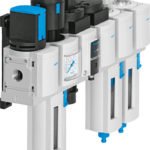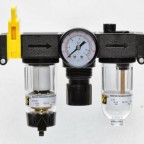By Josh Cosford, Contributing Editor
Pneumatic systems are widely used within industrial environments to power machinery and equipment, providing reliable and efficient performance. The Filter-Regulator-Lubricator (FRL) is vital in maintaining optimal air quality and pressure within these systems. However, when selecting an FRL, one must not overlook the significance of understanding FRL air flow characteristics, which is more complex by nature than more simple components. By comprehending and considering airflow, one can make informed decisions to enhance system performance, reduce downtime, and extend equipment lifespan.

Airflow is critical in determining the efficiency of pneumatic systems, as any pressure created to overcome restrictions is forever lost as heat. An FRL matching the system’s required flow rate ensures that the equipment and actuators receive an adequate supply of clean, pressure-regulated air. Insufficient airflow can lead to decreased system performance, slower actuation times, and compromised productivity. On the other hand, oversized FRLs may result in unnecessary energy consumption, increasing both capital and operational costs. Understanding air flow helps strike the right balance, optimizing efficiency and maximizing output.
Regulating air pressure is crucial to ensure safe and reliable operation of pneumatic systems. By understanding airflow requirements, one can select an FRL that can effectively regulate pressure within the desired range. Insufficient pressure control can result in erratic actuation, unstable operation, and potential damage to components. Conversely, excessive pressure can cause leaks, premature wear, and even equipment failure. FRLs’ flow characteristics are described in two ways — flow rate and pressure drop.
The flow rate through an FRL is dictated partially by the size of the filter, regulator and lubricator, as well as the construction style of each component and the pressure setting of the regulator. The filter media construction and micron rating affect the backpressure across the filter, with deep pleated designs down to 0.01 micron tending to resist flow more than inexpensive 5-micron filters. Still, it’s easy to oversize your assembly rather than sacrifice filtration quality.
The lubricator reduces flow the least in the FRL and instead is just an oil reservoir using the Bernoulli principle to atomize the lubricating fluid into the air stream. The flow reduces slightly as it passes through the venturi, where the increase in flow rate reduces localized pressure, thereby pulling oil up the capillary tube where it’s introduced into the air stream.
The regulator influences airflow the most through an FRL and, by its very nature, may restrict flow to subsequently reduce pressure. The essential function of a regulator inherently restricts airflow to reduce downstream pressure. Using poppets, pistons or diaphragms, the regulator’s spring and its preload control the force required to open the valve and allow flow to occur. Users may adjust the spring tension to adjust the preload to increase the pressure that prevents the restrictive element from closing as easily. The regulator seamlessly balances the restriction with the outlet pressure to smoothly control pressure at the desired setting, opening the valve to increase pressure or closing it to reduce pressure.
Regulators have an operating range best suited to their design, and any pressure and flow used outside that range results in either weak pressure control with unstable flow or a locked regulator with no flow. Downstream pressure must remain well enough below the regulator set pressure, or the unit may lock up and allow no flow at all. Conversely, when the flow is high while pressure is low, much energy is wasted to pressure drop. It’s also important to know that the higher you set your regulator, the less it will flow. As previously mentioned, the regulator restricts flow to reduce pressure, so trying to regulate pressure in the upper reaches of the design range may restrict flow to an unacceptable degree. Be sure to select a regulator that flows well in the upper-pressure range, should you need it.
The above descriptions are simplified because regulator design is surprisingly varied. Singe stage regulators work well with stable, low-pressure regulated machines and tools. However, if your plant’s air usage varies widely or machine demand is not stable and constant, a two-stage regulator provides a superior choice. In some cases, regulators are also available with the pressure-compensated option that helps maintain stable flow despite fluctuations from inlet or downstream pressure.






Leave a Reply